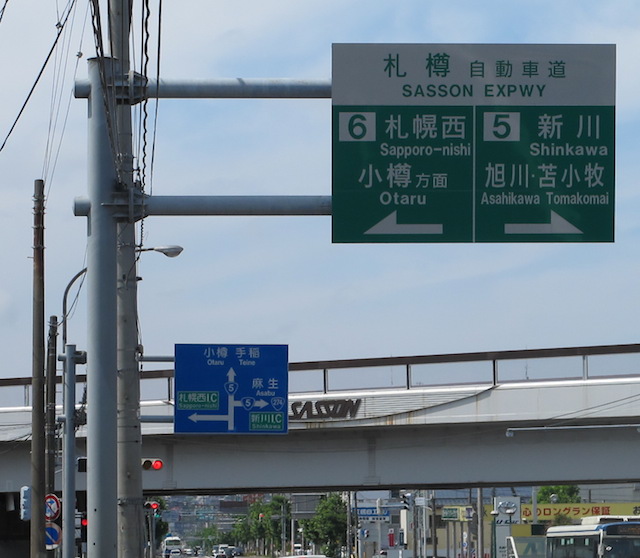札樽自動車道: Sasson Expressway
This is the first page where the two main themes of this site come together: Highways and Japan. Today's topic: The Sasson Expressway, a 38-kilometer toll road in Hokkaido. If you step outside the Shiroi Koibito Park (and chocolate factory) in Sapporo, you'll see the signs below.

Let's break down what we see on the sign.
It's pretty common (though not universal) for Roman letters and some English words to accompany the Japanese text on signs.
自動車道, for Expressway, literally means "automobile/motor road". 高速道路 ("high-speed road") is another term for expressway.
名前の意味: Meaning of the Name
The name Sasson (札樽) is a portmanteau of the two cities at each end of the expressway: Sapporo (札幌) and Otaru (小樽). In romaji, "Sasson == Sapporo + Otaru" isn't obvious; but in the kanji, you can see the first character of Sapporo (札) and the second character of Otaru (樽) but using the on-yomi (ソン) instead of kun-yomi (たる).
樽 means "barrel, cask, keg" and would be appropriate for Sapporo (famous for its eponymous beer). Might Otaru (literally, "little keg") be named after beer? No, just a coincidence; the name is of Ainu origin, possibly referring to the river meeting a beach. The name of Sapporo itself also originates in Ainu, for "dry, great river." The significance of the Japanese names is phonetic, not semantic.
I don't remember ever seeing signs on intersecting roads in the United States referring to freeway exit numbers; but it's common in Japan. The interchanges here have numbers and names.
The name of Interchange 6 is 札幌西 (West Sapporo) and leads toward 小樽 (Otaru). 方面 means "direction". If you'd like to know more, there's a detailed Wikipedia page (in Japanese) for that interchange.
Interchange 5, 新川 ("new river"), heads toward the cities of 旭川 (Asahikawa) and 苫小牧 (Tomakomai), which are opposite directions along the Hokkaido Expressway, where the Sasson terminates. (If you'd like to know more...)
自動車道について (More about Expressways)
Japan has more than 5,000 miles of expressways; these roads are equivalent to American freeways, with access fully controlled using interchanges.
All expressways are toll roads, and most tolls are proportional to distance. The rate for a passenger car is about 25 yen per km, which is more expensive than tolls along most American roads. For example:
- 103 miles along the Massachusetts Turnpike (I-90) from West Stockbridge to Westboro: $3.50
- 100 miles along a Japanese expressway: about $36
However, the Sasson Expressway from IC 6 to its eastern terminus is a flat-rate zone, where the toll for passenger cars (as of this writing) is 410 yen.
自動車道 ナンバリング (Expressway Numbering)
Until recently, most expressways outside the Tokyo area were given names instead of numbers. In October 2016, however, Japan's Ministry of Land, Infrastructure, and Transport proposed a nationwide numbering system that has since been adopted; for example, the Sasson Expressway will also be designated E5A. As shown above, not all signs have been updated yet; but one motivator for establishing the system will be the increased numbers of tourists leading to the 2020 Olympic Games and beyond.
Why "E5A"? "E" means Expressway (in contrast to "C" for circular routes); and "5A" means "part of the E5 family", where E5 is the Hokkaido Expressway. E5 gets its number from being related to National Route 5, a road leading from Hakodate to Sapporo.
Links
- Expressways of Japan (Wikipedia)
- Toll Calculator, Massachusetts Turnpike
- Sasson Expressway (wiki, English)
- Sasson Expressway (wiki, Japanese; much more detail)
- New Japan Expressway Numbering System
- New Japan Expressway Numbering Map